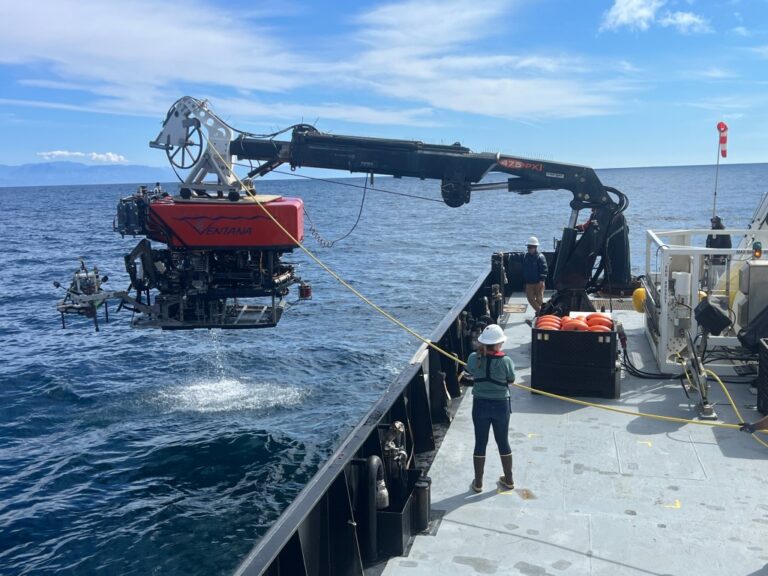MBARI’s ROV, Ventana being deployed at the proposed restoration and research site, Sur Ridge. (Brian Phan – Herald Correspondent)
Deep-sea coral restoration and research sites are being proposed to protect deep-sea habitats from bottom fishing gear in Monterey Bay National Marine Sanctuary.
“Throughout the world, we’ve been damaging deep-sea corals even before people really even thought about them,” said Andrew DeVogelaere, a research ecologist for NOAA’s Monterey Bay National Marine Sanctuary. “When people see them now, they’re beautiful and inspiring.”
On Thursday, the Pacific Fishery Management Council, which manages commercial, recreational, and tribal fisheries in Federal waters off of Washington, Oregon and California, will analyze the potential impacts of fishery closures to protect deep-sea corals from bottom contact gear at three potential sites – Sur Ridge, Año Nuevo Canyon, and Ascension Canyon.
At these depths, bottom contact gear could include traps or set longlines for sablefish, also known as black cod.
“Just like on land, there are some special places we don’t want to lose, like Yosemite or the Grand Canyon or beautiful areas from mining or from other sorts of human activities,” said Jim Barry, a senior scientist at MBARI “So we set them aside to protect them.”
The proposed deep-sea coral research and restoration areas vary in size, with Sur Ridge being 36.64 square nautical miles, Año Nuevo Canyon being 6.5 square nautical miles, and Ascension Canyon being 2.96 square nautical miles. The depths in these areas range from 1,574 to 5,118 feet.
Fishing for black cod
Black cod live in deep water ranging from 650 to 9,000 feet deep, and in California, set longlines are used to harvest them.
“It’s like a piece of rope with hooks every 18 inches on it, pre-baited and laid out over the ocean floor,” said Walter Deyerle, the captain of the F/V Sea Harvest IV. “It’s about a mile long with an anchor on each side that goes to a buoy.”
wo to three days a week, Deyerle catches black cod and distributes it.
“Last time, I fished down at Carmel Bay. It’s more localized for us smaller boats,” said Deyerle. “But a lot of the bigger boats go closer to the Ascension Canyon closures that are proposed.”
The Half Moon Bay and the Santa Cruz fishing fleet mainly fish around Ascension Canyon for black cod.
In 2022, California’s black cod commercial fishery was valued at over $6 million.
Black cod is known for its buttery, flakey meat and, locally, is one of the main fish used in fish and chips. Black cod caught in California is one of the “Best Choices” for sustainable seafood by the Monterey Bay Aquarium Seafood Watch.
“There might be some pushback from fishermen if we targeted areas for protection that were really key fishing locations for them,” said Barry. “But right now, we’re trying to find that sweet spot.”
Opposition
Many fishermen believe these protected areas would be just the start for future closures to restrict black cod fishing. Deyerle believes these closures are better than previous closures but struggles to believe they should start closing deepwater fishing grounds based on protecting coral.
“It really is a slippery slope. They start closing for coral and just expand, expand, expand, expand. Pretty soon, we won’t able to fish black cod around here,” said Deyerle.
The Santa Cruz Commercial Fisherman Association strongly opposes the proposal according to Tim Obert, a local commercial fisherman.
“If these closures take place, it will take away the very small […]
Full article: www.montereyherald.com

